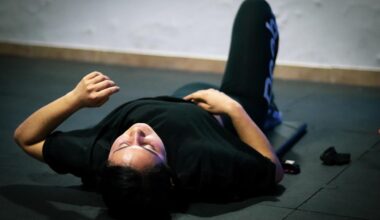Tips to Improve Your Cycling Cadence and Efficiency
Cycling is not only a fantastic way to stay fit but also a highly technical sport. An important aspect to focus on is improving your cadence and efficiency. Cadence refers to the number of times your pedals rotate in a minute. A higher cadence allows for smoother cycling and often increases speed. To find your optimal cadence, start tracking your revolutions per minute (RPM) with a bike computer or smartphone app. Aim for a cadence of around 80-100 RPM for optimal performance. Additionally, ensure that you have the appropriate gear ratio set for your cycling style and terrain to allow for effective cadence adjustments. Remember, not all cyclists are the same, so what works for one person may not work for you. Incorporate a variety of gears into your rides, allowing you to experiment with different cadences as you climb hills or race on flat surfaces. Take detailed notes on your efforts and performance to refine your training regimen accordingly. Don’t forget to listen to your body, as fatigue can affect your cadence significantly.
Another way to improve your cycling cadence involves strengthening your leg muscles. Make sure to include strength training in your fitness routine at least twice a week. Focus on exercises like squats, lunges, and calf raises to enhance your overall cycling power. A strong core is also crucial for maintaining stability and balance while cycling. Consider integrating planks and rotational exercises into your workouts to improve core strength effectively. When you are cycling, ensure that your bike fits you perfectly, making adjustments to saddle height, saddle position, and handlebar height. A proper fitting bike will not only enhance your efficiency but also provide the comfort you need to maintain your cadence over longer distances. Don’t overlook the importance of flexibility; stretching before and after your rides will help increase your range of motion. This can contribute to a more efficient pedal stroke, allowing you to maintain a higher cadence. To further enhance your skills, try joining cycling groups or forums online where you can exchange tips and experiences with other cyclists, thereby learning new techniques to improve.
Mind Your Riding Technique
Riding technique plays a vital role in improving both your cadence and efficiency. Focus on developing a smooth and fluid pedal stroke. Your pedal stroke should not just be about pushing down but also about pulling up when the pedals reach the bottom. One effective method to achieve this is using clipless pedals, which can help engage your hamstrings and hip flexors effectively. During every ride, be mindful of maintaining a consistent tempo and avoid sudden bursts of energy that might affect your cadence negatively. Another crucial factor is to focus on your breathing as a part of cycling mechanics. Efficient cyclists develop a rhythm that incorporates proper breathing techniques with pedal strokes. Experiment with various breathing patterns to find what works for you during different phases of your ride. Engaging your entire upper body and core while riding can improve your overall cycling efficiency. Aim to keep your elbows bent and your hands relaxed on the handlebars. Flexibility in your upper body can help you maintain speed as well.
In addition to focusing on your physical routine, proper nutrition and hydration play crucial roles in enhancing cycling performance. Make sure to fuel your body with a balanced diet rich in carbohydrates, proteins, and healthy fats. Consuming the right blend of nutrients will provide the energy required for endurance rides and aid in recovery. Incorporate snacks or energy gels during long rides to maintain energy levels effectively. Hydration cannot be neglected; drink ample water before, during, and after your rides to keep your systems functioning optimally. Dehydration can significantly decrease your performance and lead to fatigue, so always keep an eye on your fluid intake. If you’re engaged in long-distance cycling, consider electrolyte replacement drinks to replenish lost minerals. Testing various hydration schedules can also be beneficial to find the most effective method before competitions or long rides. Most importantly, always listen to your body and adjust your nutrition strategy according to your specific cycling goals. After your rides, implementing recovery methods like foam rolling and getting adequate rest are vital for continuous improvement.
Set Realistic Goals
Another effective strategy to improve your cycling cadence is to set realistic and achievable goals. Establish specific targets regarding your cadence, distance, and overall performance. Start with short-term goals that can progressively build up to long-term achievements. Keeping a log or journal of your rides is essential for tracking your development. Measure your efforts by recording your cadence RPM, heart rate, distance, and the duration of your rides. To stay motivated, share your goals with fellow cyclists or friends, making the process enjoyable and engaging. Encourage accountability and celebrate milestones as you reach specific targets, whether that be mastering a new cadence or completing a challenging ride. Set up a regular training schedule, balancing hard and easy days to allow your body to adapt. Remember that every cyclist progresses at their unique pace. Doing regular assessments will help you understand where improvements can be made. Be patient with yourself; developing an effective cycling technique and improving your cadence takes time and commitment. Persist through challenging training days, and you’ll see the dividends in your overall cycling efficiency.
Cross-training activities have shown to benefit cycling performance as well. Incorporate fitness routines like swimming, running, or yoga into your regimen to strengthen muscles that cycling alone may not fully target. These activities can help improve your cardiovascular fitness, flexibility, and overall body strength. For example, swimming provides an excellent full-body workout that complements cycling, engaging core and arm muscles. Likewise, activities like running can lead to enhanced stamina and endurance over long distances. Yoga is exceptional for promoting flexibility and mental focus, which can be particularly beneficial during long rides. Adjust your training schedule to incorporate 1-2 days of cross-training each week while allowing for adequate recovery. Furthermore, try enrolling in local fitness classes that focus on various forms of exercise to keep your routine fresh and exciting. Engaging different muscle groups will prevent burn out and aid in maintaining a balanced athletic physique. Remember, the goal of cross-training is to complement your cycling efforts, enhancing your overall performance and making your cycling experience more enjoyable.
Final Thoughts
Improving your cycling cadence and efficiency is a multi-faceted process demanding dedication and determination. By incorporating the suggested techniques into your training, you will tackle both physical and mental challenges head-on. Always prioritize your comfort and safety while cycling and seek professional guidance if needed, especially when considering equipment upgrades or changes to your bike. Keep experimenting and adjusting your strategies according to your personal preferences and progress. Every ride is an opportunity to learn something new, whether about your gear, your body, or your fellow cyclists. Embrace each ride and celebrate both small victories and achievements. Be open to change; varying your routes and intensities can help you break away from monotony. Lastly, connecting with the cycling community can offer invaluable resources for motivation and shared experiences. The journey to enhance your cadence and efficiency through cycling can lead to personal growth and lifelong friendships as you engage with others on the same mission. Happy cycling!
Continually find ways to enhance your performance through innovative techniques and self-improvement strategies. A detailed approach incorporating physical training, balanced nutrition, hydration, goal-setting, cross-training, community interactions, and personal dedication will pave your path toward achieving higher cycling efficiency.


